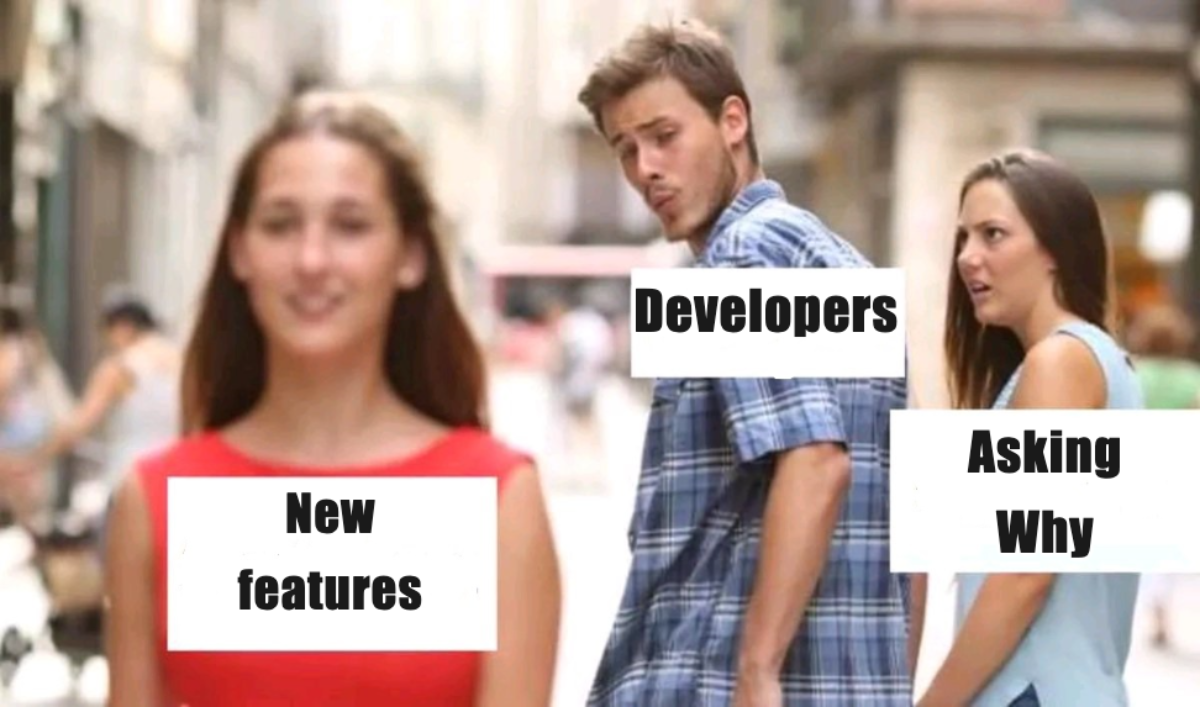Ever found yourself knee-deep in code, wondering why you’re building what you’re building? 🤔 It’s like planning a road trip without knowing the destination. It may sound fun at first but after sometime you will regret your decision. But here’s the thing – too often we get so caught up in the nuts and bolts of HOW to build something that we forget to ask WHY we’re building it in the first place. This is what I’m gonna discuss-why asking this question ‘why’ can make you an achiever.” Here is why asking ‘why’ is the secret behind all successful projects and saves you from spending all your time debugging as well as will reduce your project to an endless goose chase.
The Power of “Why”
The “why” isn’t just a question; it’s the North Star that guides your project. When you understand the underlying reasons, you can make informed decisions that keep you on track. It’s like knowing the plot twist before watching the movie—you see the bigger picture.
Imagine a team working on a new mobile app feature. If they know the goal is to boost user engagement, they can focus on creating interactive elements, rather than adding random functionalities. Knowing the “why” turns chaos into clarity.

Integrating “Why” into the Design Process
Design thinking is where the magic happens. It’s like putting on a detective hat and solving a mystery—why do users need this feature? This user-centered approach makes sure your software isn’t just pretty, but also practical.
- Empathy Mapping: Get into your users’ shoes. Understand their needs, motivations, and pain points. Bonus points if you actually try their favorite coffee order.
- User Personas: Create detailed profiles of your target users. Think of them as your project’s spirit animals.
- Prototyping and Testing: Build prototypes and test them. It’s like baking a cake—you want to taste it before serving it to guests.
By starting with “why,” you make sure your design process is aligned with real user needs, not just your whims.
Remember Spotify’s Discover Weekly? It’s not just a playlist; it’s a game-changer. Spotify didn’t just randomly decide to create this feature. They asked, “Why do users need help discovering new music?” The answer was simple: users were drowning in a sea of songs.
By understanding this, Spotify’s team created an algorithm that curates a personalized playlist every week. It’s like having a personal DJ who knows your taste better than you do. The result? Users are hooked, and Discover Weekly became a massive hit.
Case Study: Successful Project
Let’s dive into a real-world success story. A tech company aimed to develop a new customer relationship management (CRM) system. Initially, they were all about loading it with the latest features. But then, someone asked the golden question: “Why do we need this system?”
Turns out, the primary goal was to improve customer retention through personalized service. This insight shifted their focus from feature overload to creating a system that provided valuable customer insights. The result? A CRM that skyrocketed customer satisfaction and retention rates.
Key Takeaways:
- Understanding the “why” can shift the focus from feature frenzy to solving real problems.
- It leads to better decisions and more impactful outcomes.
Unsuccessful Project
Now, let’s look at a cautionary tale. A startup decided to launch a new social media platform. Excitement was high, and they dove into development, adding every feature imaginable. But they forgot to ask, “Why would users choose our platform?”
Without a clear “why,” the platform launched with great fanfare but quickly fizzled out. Users didn’t see the unique value, and the platform faded into obscurity.
Lessons Learned:
- Neglecting the “why” can lead to a product that flops.
- Asking the right questions early on can save time, resources, and heartache.
Practical Tips for Asking the Right Questions
So, how can you ensure you’re asking the right questions? Here are some practical tips:
- Start with the Basics: Ask fundamental questions like “What problem are we solving?” and “Who are we solving it for?” It’s like making sure you packed your snacks before a road trip.
- Engage Stakeholders: Involve different perspectives to uncover various aspects of the “why.” It’s like hosting a potluck—everyone brings something valuable to the table.
- Iterate and Reflect: Continuously revisit the “why” as the project evolves to ensure alignment with goals. Think of it as your project’s GPS.
- Document and Share: Keep a record of the “why” and make it accessible to the entire team to maintain focus. It’s your project’s guidebook.
The Broader Impact
Understanding the “why” doesn’t just improve individual projects; it enhances overall team collaboration and product quality. When everyone is on the same page, it’s easier to work together towards a common goal. This alignment fosters a more cohesive team environment and can lead to more innovative solutions.
Moreover, a clear understanding of the “why” can ripple outwards, influencing company culture and leading to a more purpose-driven organization. When teams are aligned with the bigger picture, they are more motivated and engaged, which translates into better products and happier customers.
Conclusion
In the realm of software development, the “why” is a powerful tool. It provides direction, purpose, and clarity, ensuring that the efforts of a development team are meaningful and impactful. By taking the time to ask the right questions and understand the underlying reasons for a project, you can avoid common pitfalls and set your projects up for success. So next time you start a new project, take a moment to ask yourself: “Why are we doing this?” The answers might just lead you to better outcomes.
